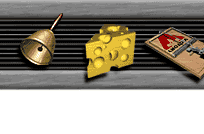





 |
 |
 |
||
 |
 |
 |
||
|
|
|
|
|
|
| Home : Behavioralist Module : Terms |
Behaviorism: A Dominant ParadigmTake a few minutes and try defining the following terms: Aversive stimuli means much the same thing that punishment means. It is noxious and so you want it removed. When a behavior elicits an aversive response(aversive stimuli), the behavior received a response that was viewed as negative, so as not to receive the negative response again, the subject will not repeat the behavior. An example could be that when a child goes out to play in the snow, a bully puts snow in their ears. The child will stop going out in the snow to avoid the aversive stimuli(snow-packed ears), and eventually the snow playing is extinguished(kid stays in and plays with tinker toys), which is the result that a behaviorist would expect. Backward Chaining is one of the three ways that a stimulus-response chain is formed. A stimulus-response chain is basically made up of behavior shaping, reinforcement and raising expectations. In backward chaining the first step is the last step, until a behavior is broken down into understandable parts that can be done in forward sequencce. The whole time rewarding(positively reinforcing) behavior and raising expectations. An example may be teaching a child how to eat. First the child is shown how to put a spoon in their mouth, when they get it right they are given a piece of candy(reinforcement), then to get the piece of candy they must then be able to get a spoonful of peanutbutter and then put the spoon in their mouth(raising expectations). Finally the child must be able to sit in front of a bowl of soup, and successfully fill the spoon, raise it to their lips and consume the spoon's contents before they get the piece of candy.The baseline is the normal occurence of a behavior. It is measured by observing the normal rate of any particular behavior. It is extremely important to behavioralists and statisticians, because without this measure it is unclear if any progress is made towards goals. An example of establishing a baseline, would be to watch a child in the classroom, and count the number of times off-task(baseline), before a program to help the child stay on-task begins. Behavior Contracting is specifying rule-governed behavior. Essentially writing out the way the child will behave, what they will do, and what they will do to prove the specified behavior has been done. A behavior contract includes contingencies(punishments) if the child fails to perform the required behavior, and rewards if they succesfully complete the contract. An example of a behavior contract would be a written agreement between a teacher and a child in her class who has a problem with touching other students inappropriatly. The contract would define appropriate and nonappropriate touch. The contract would define rewards(positive reinforcement) if the child can stop and show s/he has stopped inappropriate touching. The contract would also include a series of punishments, if the child continues to touch inappropriatly.Behavior Modification is a group of ideas that suggest through reinforcement or punishment, on different schedules, a behavior can be either taught and ingrained in a person/animal, or completely extinguished. An example of a behavior modification program would be putting an alcholic on antabuse(a drug that when combined with alcohol makes the person violently ill). Whenever the alcholic feels like drinking they become very sick(punishment). As long as they are not drinking anything, they feel okay. The system is designed to extinguish drinking. Classical conditioning was the first system of conditioning. In classical conditioning a stimulus is paired with a response. Each time the stimulus is used the response then follows. After awhile a stimulus that is normally unconnected with the response is introduced. After awhile the unconnected stimulus elicits the response without the connected stimulus. This is classical conditioning, an it was first outlined and described by Ivan Pavlov. A good example to use is Pavlov's own incidental experiment. Every day the doorbell would ring because the man who delivered meat would come to bring the dogs food. At first the dogs would salivate when they were given their food. Eventually, they paired the sound of the doorbell, with getting their dinner, and they would salivate every time the doorbell rang. This is the most famous classical conditioning example. Extinction is the desired outcome for some behavioral modification plans. It is, basically, an undesirable behavior that disappears completely from the repertoire of the person. Usually extinction is brought about by not responding to a behasvior what-so-ever. Behaviorists believe that the best example of extinction is in babies learning the basic sounds for their native language. The child makes many different noises as they explore their ability to communicate. But only some, the ones that sound most like the native language are attended to and therefore reinforced. After awhile the child only makes noises that will be reinforced, and all the other sounds become extinct. Generalizing is deciding that a stimulus is enough like another stimulus that it should elicit the exact same response that it would have if it were the original stimulus that it has been paired with. This decision may not always be conscious. An example would be, if at noon one day, when you were extra hungry,you are driving down fast food alley in your town. You see a billboard of a hamburger, and even though you have not eaten that particular hamburger before it makes you salivate. You have taken your experience of eating hamburgers and liking them, and generalized it to that hamburger being good. The generalizing stimuli, is the paticular object that made you generalize. It is the antecedent that causes the generalization. If you use the example in the definition before this the billboard is the generalizing stimuli. Ignoring, is simply, ignoring. Not responding in any way to a behavior until it at some point becomes extinct. An example of ignoring would be, if your dogs whines at the edge of your bed to pick them up and let them sleep with you, and you pay no attention(ignore)to them, eventually they will stop whining at the edge of your bed. (Though the whining may become extinct, this does not mean they will not find a more obnoxious replacement behavior, or that the whining will not get much worse before it stops). An intervention is the use of a behavioral procedure. It is used to affect(change) the way a person is behaving. An intervention would be walking over to a study group and focusing them in a different direction. Instead of having them talk about how Stonewall Jackson fought in the Civil War, talk about why he fought in the Civil War. Is performing something that will then be perormed by the observer to the behavior. The person who is modeled can be purposefully exhibiting the behavior so it can be copied or they might be inadvertantly modeling a behavior that will then be performed by the behavior observer. Children are very good at watching others perform a behavior, and then copying it. A good example of inadvertant modeling is children, after watching a JIm Carrey movie will begin to imitate the faces, and inappropriate behaviors that he is performing(modeling) for them. A form of purposeful modeling is when you begin to teach a child to drive. You tell them and show them all of the ways that they are expected to behave, so that they will be able to perform them when they get behind the wheel. Negative Reinforcement may be confusing at first glance. It conjures the idea of punishment. It is actually a way to increase the occurence of a behavior. When a behavior is exhibited, something that the participant dislikes is taken away. So every time the desired behavior occures a noxious agent is removed, therefore reinforcing(negative reinforcement) the desired behavior. A classroom example is the teacher who tells her students that if they work now, they will not have to do homework later. (This sets up a very bad pattern, because it ingrains in the child that homework is a punishment instead of a learning tool.) Operant conditioning, came after classical conditioning, and is the form of conditioning that behavior modification, and most of the terms you are learning embody. In operant conditioning, a behavior is met with a reponse, either positive/negative reinforcement, or punishment and also ignoring. Through these tools, the theory states, each person is taught everything they will ever learn, and all behaviors they will come to exhibit. The theory believes that even when it is not purposeful, all behavior is met with reinforcement, punishment, or ignoring. These three things then form who a person becomes, and what they believe. An example of operant conditioning is a token economy. If the child exhibits the desired behavior, they get a token, if they do not they may lose a token or points accumulated towards a token. At the end of the week the child can 'buy' a reward using the tokens, but only if they accumulate enough tokens(positive reinforcement). Eventually the behaviors that do not get an award, and are ignored become extinct. Other behaviors that lose token points(punishment), may become extinct(they may also be saved, for later use when the child wants to get even). The behavior that produces tokens(reinforcement) becomes the child's response set. (Token economies do work, and behavior does change, but only while the token economy is in place. As soon as a child is removed from the setting they revert back to previous behavior. Overcorrection is a process of not only fixing the thing that the person has done wrong, but fixing even more than what the person has damaged so that it is better then when the damage was first done, with no opportunity to rest before the damage is repaired and the extra fixing is done. Another form of overcorrection is when the person exhibits a problem behavior, they are forced to not only engage in the activity, but do the problem activity until it becomes aversive. In the former form of overcorrection an example is having a child who has wrritten on the wall not only clean up the crayon mess, but then alsos finish washing the rest of the walls in the room. In the later form a good example is having a child who has been caught smoking, smoke so many cigarettes that they become sick and don't want to smoke anymore. Positive reinforcement is a reward for succesful completion of a desired activity. The desired behavior is exhibited, and then something desirable is given to the person. Casinos use positive reinforcement to elicit the desired behavior of gambling. You put a quarter in the slot machine, the machine spins, and then gives you $2. This then causes you to want to put in another quarter which you do in hopes of getting another reward(positive reinforcer). A prompt is a supplemental stimulus that raises the likelyhood of achieving the desired response. It is a clue that is often used when an expected behavior is unlikely to occur spontaneously. Prompts are often used in the classroom when a student is having trouble understanding an assignment. If they are writing a paper on the economy and leaving out very important information, they teacher may ask a question like, "Jimmy, can you remember last week when we talked about Gross National Product?". Reminding(prompting) the student to add in the forgotten information. Punishment is a response to an undesired behavior. If someone exhibits the undesirable behavior, then immediatly something negative, and unconnected to the behavior, happens. Many people use punishment as a means to achieve desired behavior. If you have a child in your class who refuses to sit still, and when he gets up you say, "That's it, no recess for you!". You have punished an undesired response set.(You have also punished yourself) Your repertoire is all of the things, the behaviors in your response set. It is everything that you know how to do, and will perform. The schedule of reinforcement is how often a response that is desired will be reinforced. It is true that it is rare that anyone can reinforce every desired behavior every time, so how often the reinforcement is given is its schedule. If an action is reinforced every time then you then the schedule is a continuous schedule of reinforcement. If the behavior is rewarded after x amount of correct performances it is a fixed ratio interval(schedule). If the behavior is rewarded randomly or appears to be random then it is a mixed ratio(schedule). We will return to the casino for an example. You do not win every time you pull the handle on a slot machine. In fact most people lose a lot more then they win. But because the player does not know when pulling the arm of the one-armed bandit will make them a millionaire, they keep on trying, because it could quite literally be the next pull. This is a mixed ratio schedule of reinforcement. If you won your quarter back everytime you played that would be a continuous schedule. If after every twenty pulls you won a fixed amount of money, that would be a fixed ratio. (Of all the ratio schedules the mixed ratio is the most effective.) Task analysis is breaking a behavior down to its smallest elements. A recipe that you are writing down for the first time is a pretty good example of a task analysis. You must break down the ingrediants, how to mix them, and how to cook them, in detailed order, so that the process can be understood so that each part can be easily replicated, by you or anyone else reading the recipe. Once you have completed this topic you should: Go back to Assignment 1 |
| E-mail J'Anne Ellsworth at Janne.Ellsworth@nau.edu |
|
Course Created by J'Anne Ellsworth & Center for Technology Enhanced Learning Copyright
© 2001 Northern Arizona University |
 |
 |
 |
 |
 |
|